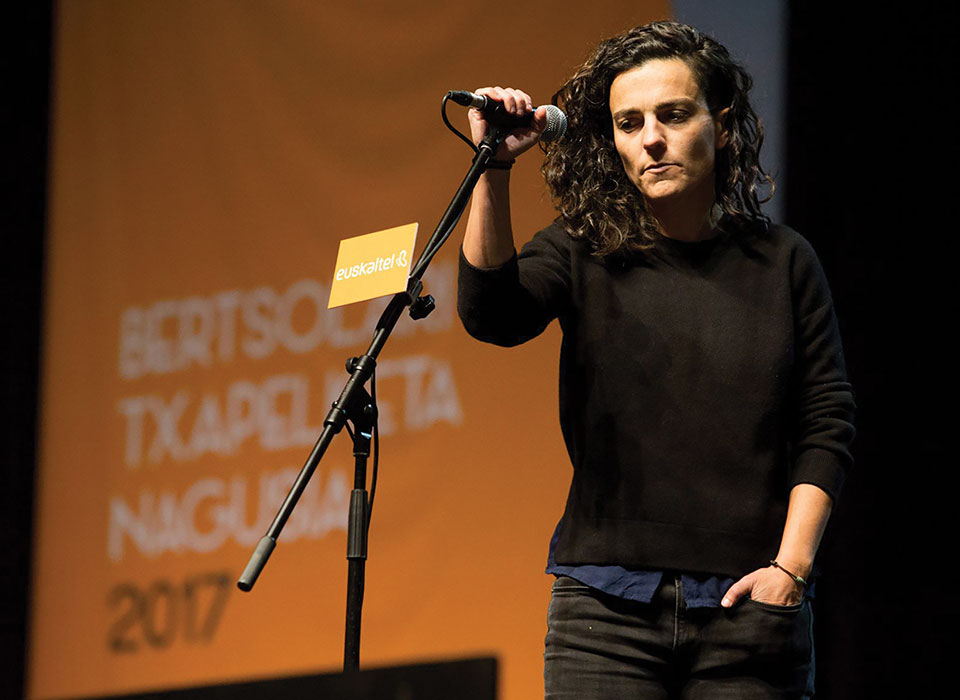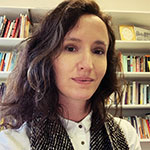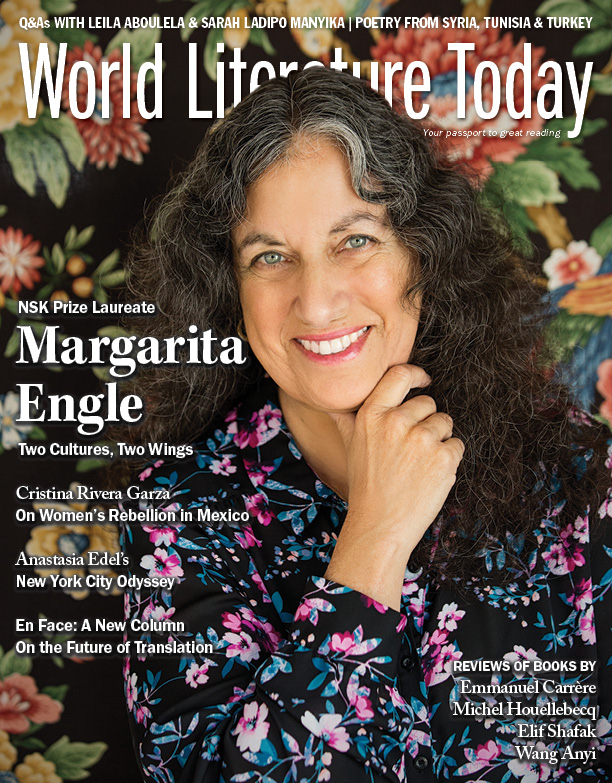Breaking the Circle: Women Writing in Endangered Languages

In Basque and other minority-language traditions in Europe such as Irish, women writers are engaging with the modern world and showing that these languages cannot simply be consigned to the past.
THE BERTSOLARIS STAND shoulder to shoulder onstage in front of the microphone. The audience is still. No music accompanies the performance, and each bertsolari waits their turn to sing. A single voice carries the melody:
Gogoratzen naiz lehengo Amonen
zapi gaineko gobaraz
gogoratzen naiz lehengo amonaz
gaurko amaz ta alabaz.
. . .
Gure bidea ez da errexa
bete legez, juizioz, trabaz . . .
Euskal Herriko lau ertzetara
itzuliko gara gabaz
eta hemen bildu dan indarraz
grinaz eta poz taupadaz
herri hau sortzen segi dezagun
euskaratik ta euskaraz.
I remember the grandmothers of old times
with their washbasins over their heads
I remember the grandmothers of old
and today’s mothers and daughters.
. . .
Our journey is not an easy one,
besieged by obstacles, trials, and laws . . .
this evening we return
to the four corners of the Basque Country,
and with strength materialized in this place,
with passion and heartbeats of joy,
let us continue building this country
from and with the Basque language.
from 2009 world bertso champion Maialen Lujanbio’s winning performance, translation from the subtitled YouTube broadcasts in English and Spanish
Basque bertso is an improvised poetry performance with strict meter and rhyme that dates back to the late 1700s, although many believe it to be an ancient oral tradition as old as the language itself. Today it’s sung from cider houses to public squares to stadiums that seat thousands for the bertso competitions held in the Basque Country of Spain. It was primarily a masculine tradition in public until recently; however, women sang bertso in the intimate spaces of the home, at women’s places of work such as sewing workshops, and women were thought to be the first practitioners of the art.
Today women compete alongside men. Maialen Lujanbio was named the 2009 world bertso champion, the first woman to ever win the competition.
Although the Basque language and oral tradition are ancient, the Basque literary tradition is quite new. Its first novel, Kresala (Saltwater), about the lives and customs of Basque fishermen, was published only in 1906. In the essay collection Writers in between Languages, Basque writer Iban Zaldua said, “Our written literary tradition is rather poor, not to say totally impoverished, or at least it was until the 1960s,” with only a few hundred texts, many religious, to form the literary canon. Under Franco’s dictatorship (1938–75), Basque was forbidden from use in public, including schools; all Basque newspapers were banned; Basque names were changed; and even tombstones were scraped and re-engraved with Spanish names. The language suffered until Franco’s regime collapsed.
With seven dialects spoken, Basque was standardized in the 1970s as euskara batua, which became the language of the Basque written word. Today there are more than a thousand titles published in euskara batua per year. And for the first time, there are three generations of writers writing at the same time. It’s a new life for the ancient language.
For the first time, there are three generations of writers writing at the same time. It’s a new life for the ancient language.
Basque is one of 640 languages in danger of extinction in Europe, according to unesco. There are approximately 750,000 Basque speakers today and, like any language, many fewer readers of literature. Writers and bertsolaris rely on translation to reach larger audiences.
Bernardo Atxaga, one of the most renowned writers in the Basque language and author of the short-story collection Obabakoak, asks in his essay “The Cork and the Anchor”: “All authors who write in a minority language at some point find themselves struggling to answer a basic question: Why do you do what you do? Why do you write in a language that few understand, instead of choosing any one of those occupying a central orbit in the solar system of languages?”
Few minority-language writers are monoglots. Basque writers are usually fluent in Spanish or French, Irish writers in English, Provençal in French, Romansh in German. So why write in the lesser-read minority?
For women writers of minority languages, such as award-winning Basque writer Miren Agur Meabe, writing in Basque is an “act of reaffirmation” of her culture and history as well as “an act of renovation and modernity that chooses to turn stereotypes about women around.”
Women writers are working toward representing new and important perspectives that break away from the circle of patriarchal tradition. Women are renovating minority languages by introducing modern and diverse perspectives in the culture of that language.
When you stop seeing literary output in a language, it signals its extinction, but women writers are working toward representing new and important perspectives that break away from the circle of patriarchal tradition. Women are renovating minority languages by introducing modern and diverse perspectives in the culture of that language. In Basque and other minority-language traditions in Europe such as Irish, women writers are engaging with the modern world and showing that these languages cannot simply be consigned to the past.
The Basque literary tradition, like bertsolaritza (the art of bertso), has only very recently included women voices in its canon. In 2002 Cinco Escritores Vascos: Entrevistas de Hasier Etxeberria (Five Basque writers: Interviews with Hasier Etxeberria) featured the first serious collection of interviews of Basque writers, yet all the writers were men. In 2010 Ocho Universos, Ocho Escritoras (Eight universes, eight writers), edited by Ana Urkiza, was produced in reaction to Cinco Escritores Vascos. It features interviews with eight Basque women writers and states that, of published Basque writers, “only 15 percent are women.” In the collection, the writer Laura Mintegi states that “all of our references are masculine, and our preferences are formed by these models.” But as more women publish, they are changing the literary landscape.
In an interview I conducted with the 2019 winner of the English PEN award, writer Karmele Jaio said, “Today some of the most important works in Basque literature are written by women. Women have refreshed the panorama with new themes that explore relationships between women. Until now, most of the female characters were someone’s mother, someone’s wife, someone’s daughter—this someone, of course, always was a man.”
Jaio’s novel Amaren Eskuak (Her Mother’s Hands) focuses on the familial relationships between three generations of Basque women. Through imagistic, associative connections, the novel weaves several timelines, all in the present tense. In one, Nerea’s boyfriend, Karlos, disappears to join the Basque separatist group ETA, depicting in great detail how his disappearance without a word haunts her for years. We learn not of Karlos’s ideologies or terrorist activities but of Nerea’s pain through her point of view.
Writer Itxaro Borda notes in Ocho Universos, “I believe that I have a certain ability to observe and describe observations. It’s clear that the way I observe is different than the way a man observes. We look at the same object, but we don’t have the same point of view.” Borda’s work explores the perceptual differences of women, often queer women. Her novel 100 Percent Basque, which won the Euskadi Prize for Literature in 2002, addresses the question of national identity from a feminist and multicultural point of view. Her detective novels, which feature a lesbian protagonist from the rural world of the French Basque Country, embrace a lesbian gaze and offer criticisms of her country’s patriarchal views. In Amorezko Pena Baño, we find a criticism of Basque nationalism, which claimed to be a “people’s country”: “semeen semeetatik baitator semea, hegoaldeko nahiz iparraldeko anai . . . hitz egiten zen une oroz irratietan, egunkarietan, mitinetan, denetan, jendaldearen erdia ahanzten zen” (son to son, brother to brother, from the South or North . . . on the radio, in the newspapers, in the rallies, half the crowd was forgotten). Her writing takes on the complicated relationships between feminism and nationalism, which often have conflicting ideological positions.
LIKE THE BASQUES under Franco, the Irish have also undergone political oppression and upheaval. Both experience a unique postcolonialist point of view. Both present a modern, evolving linguistic identity in an ancient language.
Aidan Mathews’s poem “The Death of Irish” (1983) captures the sense of futility felt by some Irish-language revivalists trying to keep the language alive. Some gaeilgeoirí, that is, the Irish-speaking population, worry the language will become obsolete.
The tide gone out for good,
Thirty-one words for seaweed whiten on
the foreshore.
In the 1995 New York Times article “The Corpse That Sits Up and Talks Back,” one of the best-known Irish-language poets, Nuala Ní Dhomhnaill, asks, “If Irish is dead, what does that make me? A walking ghost? A linguistic specter?” The fact that minority- language writers need to publicly justify their linguistic choices is only a reflection of the outside world, which looks upon the minority writer as an exoticism, producing precious objects not accessible to them and therefore curious and abstruse.
Another of Ireland’s celebrated Irish-language poets, Biddy Jenkinson, writes in a letter to the editor of the Irish University Review, “I would prefer not to be translated into English in Ireland. It is a small rude gesture to those who think that everything can be harvested and stored without loss in an English-speaking Ireland. If I were a corncrake I would feel no obligation to have my skin cured, my tarsi injected with formalin so that I could fill a museum shelf in a world that saw no heed for my kind.”
Literary anthologies up to the 1950s and ’60s did not include Irish-language writing, even up to the 1970s, despite many who supported the language’s revival. The Celtic Twilight of the late nineteenth century, continuing into the twentieth century, championed Gaelic culture, including its folklore, fairy tales, and legends, which found their way into much of literature such as W. B. Yeats’s The Celtic Twilight: Faerie and Folklore, published in English in 1893.
Women writers in the Irish language often call upon folklore in their work, offering a distinctive feminist view. In Sleeping with Monsters: Conversations with Scottish and Irish Woman Poets, Ní Dhomhnaill remarks, “I think I’m very lucky in being Irish because the Irish language wasn’t industrialized or patriarchialized. And many things, including this idea of a deeper quality, this negative femininity, this Hag Energy, which is so painful to mankind, hasn’t been wiped from our consciousness, as it has in most cultures. Irish in the Irish context is the language of the Mothers, because everything that has been done to women has been done to Irish. It has been marginalized, its status has been taken from it, it has been reduced to the language of small farmers and fishermen, and yet it has survived and survived in extraordinary richness.”
Ní Dhomhnaill’s poetry fully embraces Gaelic tradition in Irish in original and subversive ways, much more so than English-language writers in Ireland, who have turned to her work and translated it in order to “derive from the experience a sense of greater abandon in the presence of the Gaelic material,” as noted by Irish scholar Declan Kiberd. Her work is rooted in the oral tradition of the West Kerry Gaeltacht, and her creativity springs from her relationship with the language and its connection with the “otherworld,” a term she noted that psychologists have latched onto as the “unconscious” but already existed in Irish’s ancient linguistic memory.
If the Irish language belongs to both the pre-industrialized world of seaweed and of rich and ancient folklore, it also belongs to the modern world. According to the Irish Times, recently the word turscar, “dead seaweed deposited on the beach by the retreating waves,” has become the term used for spam email in Irish. The Irish language is ideally suited to provide a connection to its folklore, much more so than English, and in Ní Dhomhnaill’s work, the modern world and the “otherworld” of folklore coexist.
In her poem “An Crann,” a fairy woman intrudes on the speaker’s suburban garden and cuts down her tree with a Black and Decker chainsaw:
Do tháinig bean an leasa
le Black & Decker
do ghearr sí anuas mo chrann.
D’fhanas im óinseach ag féachaint uirthi
faid a bhearraigh sí na brainsí
ceann ar cheann.
“As for the Quince”
There came this bright young thing
with a Black & Decker
and cut down my quince-tree.
I stood with my mouth hanging open
while one by one
she trimmed off the branches.
translated by Paul Muldoon
Pharoah’s Daughter, 1993
“The Tree”
The fairy woman came
with a Black and Decker.
She cut down my tree.
I watched her like a fool
cut the branches one by one.
translated by Michael Hartnett
Selected Poems, 1988
The poem’s “bean an leasa” is a traditional folk figure familiar in Ireland. Muldoon’s bean an leasa is translated here with a modern incarnation, “this bright young thing,” while Michael Hartnett’s translation is more true to the original as “the fairy woman.” Bean an leasa has been translated in other texts as the “the woman of the fairy mound” and “the changeling of the fairy fort,” and is literally translated as “the woman from the fairy ring.” No translation in English fully captures the references of bean an leasa, a supernatural fairy figure who kidnaps husbands or children and imprisons them in her rath, the remains of ringforts and hillforts found along the Irish countryside that have inspired song and legend. Perhaps the folklore reference is almost impossible to bring out in English at all, which highlights how important the language really is to cultural expression.
The presence of the Black & Decker is not the only occurrence of the modern and ancient in Ní Dhomhnaill’s work. Another bean an leasa can be found as a hitchhiker in her poem “Bean an Leasa mar Shiobobshiu loir” (The fairy hitchhiker). In “Peirseifine,” a seductive demon drives a BMW in a contemporary version of the Persephone legend. In “An Bhatniil” (The battering), an abducted child in need of Sudocream is mistreated by the fairies, the fairy abduction story seen as a metaphor for postnatal depression.
Poet Ailbhe Ní Ghearbhuigh’s 2016 book, The Coast Road, also works in this tradition. Her poem “Ceathrúintí na n-Éan” (Bird quatrains) speaks to Ní Dhomhnaill’s mermaids, Ní Ghearbhuigh’s “éan-bhean” (swan-woman), and the legend of the Children of Lir. Her poems in this collection showcase the work of thirteen different translators, and “Filleadh ar an gCathair” (Back to the city) was chosen as Ireland’s EU Presidency poem in 2013 and was shortlisted for RTÉ’s “A Poem for Ireland.”
Éilís Ní Dhuibhne, recipient of the Irish PEN award and shortlisted for the Orange Prize for fiction, is a scholar of folklore in the Irish language and publishes in both Irish and English. Folklore inhabits much of her work in both languages, such as the play Dún na mBan Trí Thine (The fort of the fairy woman is on fire) and her English-language short-story collection Midwife to the Fairies. Many of her Irish-language novels embrace detective themes like those found in Scandinavian noir, including her novel Dúnmharú sa Daingean, a best-seller in Irish. It sold approximately three thousand copies, a small print run in an international context, but considerable with only seventy-three thousand Irish speakers today.
In a conversation I had with Ní Dhuibhne, she said she hasn’t been an ardent Irish-language apologist but that writing in Irish is an important part of cultural activism. The gaeilgeoirí believe “Irish is part of who we are, and if it dies, an important part of the culture dies. Ireland isn’t really Ireland without the language.” But her reasons for writing in Irish are more emotional. She was given the language by her parents as a gift—the language of her ancestors. She didn’t want to be the one who severed the link.
Having spoken with women writers working in these minority traditions, I discovered that writing in an endangered language is an act of defiance to establish their identity as well as an act of giving and gratitude, giving of their creative selves and gratitude that they should have been born into such a privileged language.
Women’s voices only increase the relevancy of endangered-language literatures.
About writing in an endangered language, bertso champion Maialen Lujanbio said, “The objective isn’t to become one in this world, it is to be ourselves, and to let our identities become known, but always in our own way.” And women’s voices only increase the relevancy of endangered-language literatures. Representing experiences not represented before in that language can only help keep it alive. To do that means breaking patriarchal tradition in the literary canon, breaking away from normative cultures that silence important marginalized voices.
In her book Dreams of Trespass, Moroccan feminist Fatima Mernissi asks her aunt Habiba how women grow wings. “There are two prerequisites to growing wings,” Habiba answers; “the first is to feel surrounded, and the second is to believe that you can break the circle.”
Allentown, Pennsylvania











